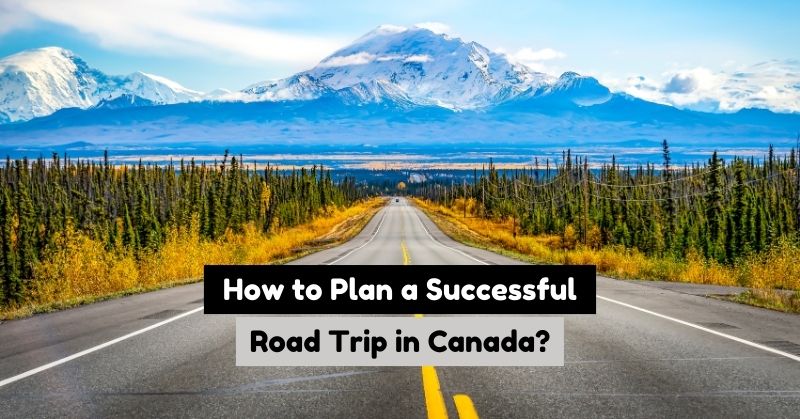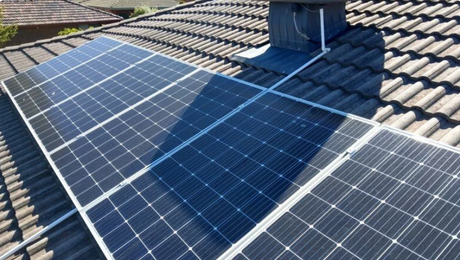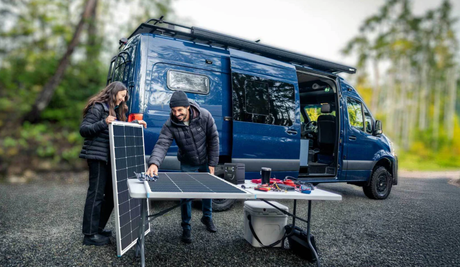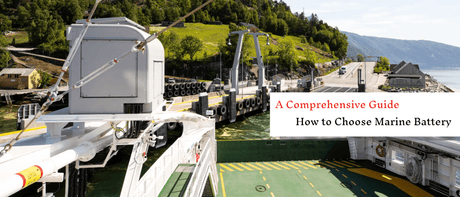Hitting the open road has always been a special moment for millions of people worldwide. It becomes even more special if the road takes you through the breathtaking landscapes of Canada. With vast prairies, towering peaks of the Rockies, and the Atlantic's rugged coastlines, this country is a beautiful place you should explore by road.
Whether you want to plan a scenic gateway or a cross-country adventure, smart planning is key. Are you wondering how to plan your road trip in Canada? How do you pick the best routes and visit must-see spots? This article covers everything, including planning stops, budgeting, and much more.
Ready to hit the road? Let's get into the essential details for planning your dream adventure.
Why Does Planning Your Road Trip Matter?
Though exploring Canada by road is a lifetime adventure, improper planning may spoil your journey's experience. The unique geography of the country offers a mix of scenic spots and logistical challenges. Therefore, make sure you are well-prepared before you leave. Let's look at the unique challenges you may face while you are on the road.
- Vast distances: The distance between Vancouver and Toronto is around 4,000 km. It takes more than 40 hours to cover this distance.
- Unpredictable weather: Different parts of the country may have different atmospheric conditions, such as foggy coastal highways in the Maritimes and snowy mountains in the Rockies.
- Limited services in remote areas: Don't forget to plan emergency supplies and fuel stops, as cell service, accommodations, and gas stations can be limited in places like Northern Ontario or Yukon.

According to News Wire Canada, over 65% of Canadians prefer road trips over air travel. The reason behind this preference is the benefits they get from the road trips, such as reduced stress levels, increased happiness, and a boost to mental well-being.
Define Your Road Trip Objectives
Before you start the journey, knowing what exactly you want from this road trip is crucial. Therefore, you should plan out a road trip with clear objectives. Whether you love outdoor adventures, cultural discoveries, or breathtaking sceneries, Canada has something special to offer.
1. Do You Love Scenic Views?
Are you on the hunt for must-see landscapes? Consider the routes below.
- Sea to Sky Highway: This scenic track is located between Whistler and Vancouver. It offers mountain vistas, fjords, and waterfalls.
- Icefields Parkway: This route through the Canadian Rockies offers towering peaks and glaciers.
- Cabot Trail: This coastal road is located along Cape Breton Island. You can explore ocean views and dramatic cliffs over there.
2. Want to Explore the Culture?
If you are a cultural explorer, visit various spots across the country, such as Wanuskewin Heritage Park in Saskatchewan and Squamish Lil'wat Cultural Center in British Columbia (BC). Other historic sites include Rideau Canal in Ontario or the Fortress of Louisbourg.
3. Are You an Aventure Seeker?
If you are an adventure lover and are looking for outdoor activities, ensure to visit the places below.
- Tofino in British Columbia
- Banff & Jasper National Parks in Alberta
- Gros Morne National Park in Newfoundland & Labrador
Researching Your Route and Destinations
If you want to make your Canadian road trip the dream journey of your life, ensure you choose a well-planned route. It is crucial to research road conditions and destinations before leaving for the trip.
Essential Mapping Tools and Travel Sources
- Tourism Canada(Destination Canada): This is an official website that provides guides on Canadian road trip ideas.
- Apple Maps / Google Maps: These tools are ideal for point of interest, estimating travel times, and real-time navigation.
- Waze: It provides you with real-time road hazard alerts and traffic updates.
- Provincial travel websites, including Hello BC, Destination Ontario, and Travel Alberta.
Popular Road Trip Routes
Some of the most scenic routes you should drive through are as follows.
- Trans-Canada Highway: This 7,800-kilometer cross-country route runs between St. John's, NL, and Victoria, BC. It passes through diverse landscapes, beautiful cities, and national parks.
- Route 132: It offers a breathtaking drive along the rugged coastline of Gaspe and the St. Lawrence River. Remember to visit Forillon National Park and Perce Rock.
- The Viking Trail: On this historic 489 km track, you can explore wildlife, L'Anse aux Meadows, and Gros Morne National Park.

How to Prepare for a Long Road Trip?
A successful road trip in Canada is more than just a tank full of fuel. Effective planning is necessary, as you will hit the road for vast distances, remote areas, and unpredictable atmospheric conditions. Things you should never take for granted while planning your Canadian road trip are as follows.
1. Vehicle Maintenance
Though all-season tires are good for most road trips, some areas may need winter tires to drive safely in regions with the cold weather. Don't forget to top up the engine oil, fuel tank, and test your headlights, signal lights, and brakes.
2. Essential Items
You should pack essentials, including the first-aid kit (having medications and bandages), water bottles, snacks, maps, jumper cables, tow rope, a roadside emergency kit, and reliable batteries. If you need winter batteries you can count on, try the Renogy 12V 100Ah LiFePO4 battery with duo heat pads and a 12V 300Ah LiFePO4 battery.

3. Tips for Handling Remote Stretches
Follow the steps below for effective handling of long stretches.
- Download offline maps
- Carry extra water and food
- Share your route with someone else
- Always plan your fuel stops in advance
4. Wildlife Safety Tips
- Spot animals with a high beam at night
- Drive cautiously and slow down in wildlife zones. Keep an eye on the yellow warning signs.
- If you see a moose, bear, or any other animal, keep a safe distance.
- Apply brakes firmly and keep the vehicle straight to maintain control.
Budgeting Your Road Trip
The cost for fuel, food, lodging, and park passes may vary from one region to another. Eastern Canada is more affordable than remote areas and Western Canada (Alberta). The table below shows the breakdown of basic expenses.

If we talk about the cost of different accommodation types, campgrounds will cost you $30-$70 per night. In contrast, motels and high-end hotels are expensive. They cost $100-$200 per night and over $250 per night, respectively.
To lower your road trip budget, consider using Renogy solar products. Here are some recommendations:
1. The Renogy 12V/24V N-Type Solar Panel is designed specifically for Class B van road trips. Its compact and lightweight design makes it perfect for space-constrained vehicles, while its high efficiency ensures you have a reliable source of solar energy. This panel is durable and easy to install, allowing you to power your adventure without worrying about battery life, making your journey more sustainable and memorable.
2. 12V 3000W Pure Sine Wave Inverter: This inverter allows you to convert solar energy into usable electricity for your devices with UPS Transfer Switch. With built-in Bluetooth, you can monitor and control your power usage conveniently.
3. The Renogy 12V 50A DC-DC Battery Charger with MPPT is an advanced solution for keeping your batteries charged during your road trip. It can charge from either your vehicle's alternator or solar panels, offering flexibility and efficiency. With its high capacity and MPPT technology, it ensures quick and reliable power replenishment, ensuring you're always ready for the next part of your journey, enhancing your road trip experience.
Save Your Money While You Are on the Road!
Are you looking for some valuable money-saving tips? Take a look below.
- Book accommodations in advance.
- Use discount apps for urgent stays, car rentals, and food packages.
- Use gas price apps to find the cheapest fuel nearby and consider ridesharing.
Planning Your Stops and Activities
One thing that global and local travelers love the most about Canada is that it enables you to explore stunning cities, beautiful national parks, and attention-grabbing roadside attractions. Below is a list of some places you should visit in 2025 and beyond.
1. Iconic Cities
- Vancouver, BC: Best for skiing and hiking
- Calgary, AB: Known for hot springs and hiking
2. Must-Visit National Parks
- Banff National Park, AB: It offers waterfalls and scenic views.
- Gros Morne National Park, NL: Known for hiking trails, lighthouse, puffins, and moose.
3. Roadside Attractions
- The Big Nickel (ON): It is a huge nickel monument in Sudbury. A perfect place for a photoshoot.
- Spotted Lake (BC): This lake is located near Osoyoos, that offers color-changing natural mineral spots.
Additional Tips for a Successful Road Trip
- Avoid running out of gas, follow road conditions, and watch for wildlife.
- Don't forget to bring an emergency kit.
- 911 is the emergency number that works across Canada. Some parks or places have special helplines. Make sure you are familiar with them.
- Download emergency applications for sharing exact location, medical emergencies, and alerts.
A quote from a traveler: “We got stuck in an unexpected snowstorm in Jasper, but thankfully, Alberta 511 app showed us road closure. We avoided getting stranded by adjusting our route.” - Lisa & Mark, Alberta road trippers.
Case study: A solo traveler in British Columbia - Jessica - experienced a flat tire near Wells Gray Provincial Park. She asked another traveler for help and used her emergency kit because there was no cell service. A basic repair kit and a spare tire saved her hours of waiting.
Final Thoughts
Most Canadians prefer exploring the beauty of the country by road, and millions of people arrange road trips every year. However, your dream journey can turn into a nightmare without proper planning. Therefore, plan your road trip effectively before you hit the road in Canada.
The country offers a range of must-see spots, from iconic cities to roadside attractions and cultural sites to national parks. Before you leave, ensure that you fill your fuel tank, maintain your vehicle, and pack essential food items, an emergency kit, a backup power source, and tech gadgets.
FAQs about planning a road trip
1. What is the best time to plan a road trip in Canada?
The road conditions are optimal and the weather remains warm during summer months. Therefore, the best time to go on a trip in Canada is between June and September.
2. What are the hot spots to visit during a Canadian road trip?
The coastal routes of British Columbia, the beauty of Vancouver Island, spectacular Fundy Trail Parkway in New Brunswick, historic streets of Quebec City, Icefields Parkway, and the Cabot Trail Nova Scotia are some of the must-see destinations.
3. Should I plan a road trip via car or RV in Canada?
Both vehicles offer their benefits. Going on an RV trip provides you with the convenience of transportation and lodging, making the journey affordable. In contrast, a road trip in a car offers flexible accommodation options and easy navigation in urban areas.
4. How to plan a budget-friendly road trip in Canada?
Consider ridesharing, camping for accommodation, bringing your meal or cooking it on your own, use discounted apps for cost-effective fueling, and look for free campsites.
5. What documents are required to safely drive a vehicle in Canada?
You must have a valid driver's license before you start your road trip. In addition, the vehicle's registration and proof of insurance are also necessary. If you are not a resident of Canada, don't forget to bring your International Driving Permit (IDP) with your license while you are on the road.










